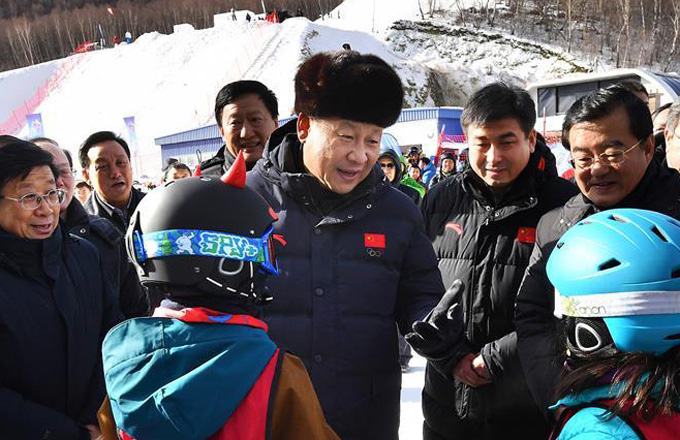Participation is seen as key to success for 'big three' ball games
Improving public participation in sports is more important to the youth development of China's "big three" ball games than medals, according to coaches and experts.
Desperately keen to see the country's soccer, basketball and volleyball teams record high-profile victories on the international stage, China's sporting authorities introduced the Under-18 category and a multi-medal reward policy in all three sports featured in the National Games. It was hoped the move would benefit the development of youth sports.
"Adding a youth competition to the games should motivate local sports bureaus to invest more resources and pay more attention to nurturing the reservoir of talent," said Xiao Tian, deputy director of the General Administration of Sport of China, at the media briefing that concluded the National Games in Shenyang, Liaoning province, on Thursday.
"It has worked out, because we've seen some young talent emerge. As long as we stick to the policy, the shallow talent pool will get deeper," said Xiao.
Held every four years, the multi-sports extravaganza has become a quadrennial assessment of the work of local sports officials, and their job evaluations are closely linked to the success or otherwise of their respective delegation's results.
The multi-medal reward policy, under which gold medals are awarded to the winners of the three big-ball sports, was initiated to encourage provincial authorities to place greater emphasis on the development of youthful talent. Unlike the Olympic Games, where each team or individual competes for a medal per event for its delegation, the multi-medal program at the National Games, awards three gold medals to the delegation of the winning team in the soccer, basketball and volleyball tournaments.
However, many coaches have complained that the policy has resulted in a rat race between various provinces, which are all seeking immediate results, and has plagued the future of sports' development.
Shui Qingxia, coach of Shanghai's women's youth soccer team, hinted that "age fixing" occurred in the Under-18 tournament at the National Games, but she refused to identify the team that selected senior players in youth games.
"Ignoring players' ages might have brought good results at the event this time round, but it will result in bad consequences at the senior level," said Shui, a member of China's silver-medal-winning women's squad at the 1996 Atlanta Olympics.
"The possibility of winning extra medals (in the Under-18 category) will stimulate the local systems to strengthen youth training during the four-year period leading up to the games, but won't guarantee a solid junior plan in the long run."
Citing the rapid development of soccer in Japan in recent years, Shui said the promotion of public participation, especially via campus programs, should be the key for the development of women's soccer in China, rather than winning medals.
"I believe women's soccer could reach the same level of achievement as my Olympic team. We can achieve this in the future if we work consistently on building on the fundamentals," she said.
Xu Genbao, a former coach of the men's national team, who now focuses on fostering young talent, echoed Shui's sentiments.
"Winning medals seems to be the only measure of our sporting development in this title-obsessed system. But if the base of the pyramid keeps shrinking, we won't have talent to call on in the future, not to mention winning any titles."
Shui and Xu's concerns have been highlighted by recent lackluster performances on the world stage.
Despite sending its strongest lineup to an international friendly game, China's men's national soccer squad lost 5-1 to Thailand's youth team in June. The defeat attracted nationwide criticism, and some people mocked the governing body's commitment to "dash out of Asia".
Once a dominant force in Asia, China's men's basketball team finished its Asian Championship campaign ranked fifth out of 15 countries and regions, its worst result since 1975. The team also fell to a humiliating defeat to Chinese Taipei in the quarterfinals of the same tournament.
In its summary of the competition, the Chinese Basketball Association admitted that the shrinking talent pool - the result of poor grassroots development - was responsible for the team's poor display.
Around 100,000 junior players compete in China's campus soccer league, but in Japan at least 1 million children in the same age group play regularly at school, according to renowned Chinese soccer commentator Zhang Lu.
The reality seems even tougher in basketball. In July, Hu Jiashi, vice-director of the CBA, revealed that only 1,000 Chinese players are registered with the International Basketball Federation, while the United States has approximately 25 million.
"There are so many children dribbling basketballs in the streets, but that doesn't contribute to the talent pool because few of them have the opportunity to develop into professionals," said basketball commentator Su Qun.
Irrespective of its positive intentions, the multi-medal policy could make the situation even worse because the most economically developed provinces tend to take shortcuts by luring promising talent from underprivileged regions with better pay and training facilities, instead of patiently nurturing their own local talent, said Lu Yuanzhen, a sports sociologist at South China Normal University.
"No one bothers to cultivate young players, instead teams spend a lot of money on buying players to get quick results. That's a negative effect, even though the policy was initiated with the best of intentions," said Lu.
Xinjiang scores on the national stage at last



















